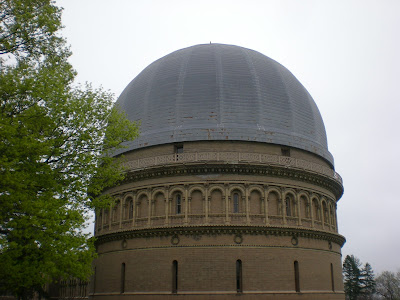Yerkes Observatory
We went to southern Wisconsin on Saturday not to discover monuments to long-forgotten fictional characters (see yesterday) -- though that's always a bonus in traveling -- but to get a look at the University of Chicago's Yerkes Observatory, which is in the town of Williams Bay, Wisconsin. We'd visited and taken the tour before, almost 10 years ago, but I was sure Lilly didn't remember and even more sure about Ann, who was in utero at the time.
I didn't mind going again. Once in a lifetime's not quite enough when it comes to seeing the world's largest refracting telescope, a 40-inch marvel. I learned this time around, or maybe relearned, that every part of the telescope except its lens had been displayed in the Manufacturers Building at the Columbian Exposition of 1893 before it was installed at the new Yerkes Observatory. So not only can you stand under an important telescope in the history of astronomy, it's an artifact of the Chicago world's fair. No doubt fairgoers appreciated it as a marvel of the age.
The guided tour was fairly short. The guide first talked about the design of the observatory, which was the work of Henry Ives Cobb. According to the University of Chicago, Cobb "was fond of ornamentation rooted in classic mythology. At Yerkes, he let his imagination roam: everywhere in the structure, both inside and out, the viewer finds hundreds of ornate, often playful representations of animals real and fanciful, signs of the Zodiac, phases of the Moon, and many other embellishments."
Such embellishments included swastikas, which the guide commented on. "We had them before the Nazis," he said, pointing them out with his laser pointer. The ones at Yerkes were non-Nazi anyway, pointing the other direction and featuring a square at the center, which is a variation I'd never seen before.
Later, I wandered around the grounds for a few minutes, and managed to take some shots of Yerkes' penile main dome in its park-like setting.
Under the big unheated dome -- Saturday was in the 50s, so it was cool in there -- is the 40-inch telescope, one of six at the observatory, and the only one seen on the Saturday tours. The guide told us a little more about the instrument, and moved it a little. He also raised the floor a few feet, and told us of the time Albert Einstein visited the observatory in 1921, passing around a photo that commemorated the visit.
The photo of Dr. Einstein and the Yerkes staff is at the bottom of this National Park Service page; the one looking Einsteinian is, in fact, the great physicist. I didn't think to ask the guide what Einstein was doing there, but from what I read later, the observatory was doing followups to Sir Arthur Eddington's observations of starlight bending around the Sun during the May 29, 1919, eclipse that confirmed general relativity, though the details of what Yerkes would do as a followup are beyond me.
Einstein is one thing, but he was only passing through. E.E. Barnard, an astronomer who worked at Yerkes, ought to be better known. I've known about him since I read about Barnard's Star in junior high (in one of the 8mm movies I made with some other junior high friends, we imagined a spaceship journeying to Barnard's Star, I think).
Besides Barnard's study of the red dwarf that now has his name, he discovered the fifth moon of Jupiter and a lot of comets, determined that certain dark regions of the Milky Way were actually vast clouds of dust and gas, was a pioneering astrophotographer and -- I didn't know this until this weekend -- was from Nashville and attended Vanderbilt, later receiving the institution's one and only honorary degree. His name remains as Barnand Hall, one of the dorms off Alumni Lawn.
Labels: astronomy, historic artifacts and sites, Wisconsin




0 Comments:
Post a Comment
<< Home